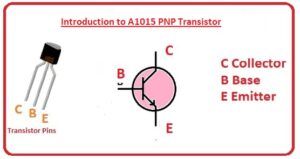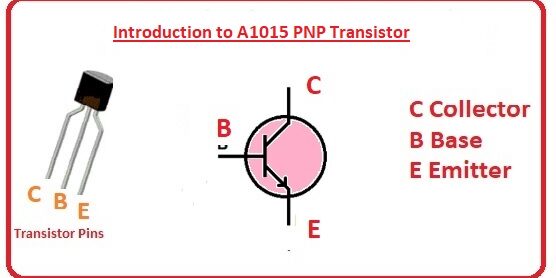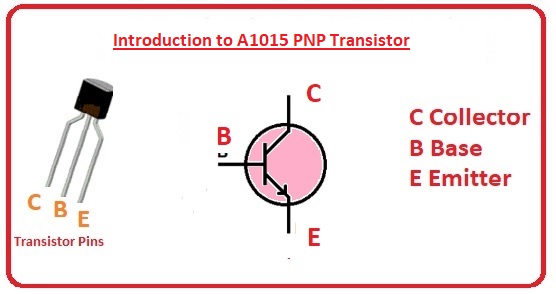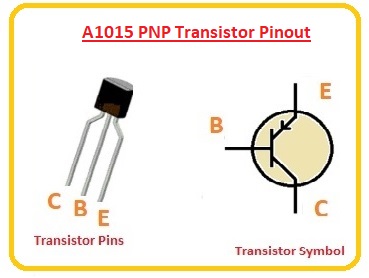 Hello readers welcome to new post. In this post we will discuss Introduction to A1015 PNP Transistor. Transistor is very commonly used electronic device that used in different projects as amplifier and switching. Its configuration is such that has three pinouts first one is emitter, second one is base and third emitter.
Hello readers welcome to new post. In this post we will discuss Introduction to A1015 PNP Transistor. Transistor is very commonly used electronic device that used in different projects as amplifier and switching. Its configuration is such that has three pinouts first one is emitter, second one is base and third emitter.
Its main types are PNP and NPN. in NPN transistor there is one N part among the two P types material. While in NPN there is two P regions and one N. Both has their own features and applications. Here we will have detailed overview about the A1015 PNP transistor features working and some other parameters. Here i further want to mentioned that if you are workings on projects where you want to used this module and has make circuit on the PCB board of your project. Facing difficulty to make it i will suggest you make contact to the most reliable and economically sound PCB provider. That offers the PCB services with reasonable prices with that they also have the high professional team of engineers and technician that will help you to make your project very accurately according to your requirements with reasonable prices. That service provider is PCBWAY that located in china and operating all over the world to their clients. their business objective is to be the most professional PCB producer for prototyping and low-volume production to work with in the world. With more than a decade in the field, PCBWAY is committed to meeting the requirements of their clienteles from different industries in footings of quality, delivery, cost-effectiveness and any other demanding requests. As one of the most experienced PCB manufacturers and SMT Assemblers in China, they pride themselves to be your best business partners as well as good friends in every aspect of your PCB needs

what is A1015 PNP Transistor
- A1015 PNP transistors are easily soldered together with a short-ball. It is used in household items. In other words, it is usually used in a different configuration.
- You need a 3.5mm ferrite spike to expose the transistor wafer to the 125C temperature, which is about 0.8million°C.
- The method of curing the transistors with a PNP transistors is also the same as a local co-crystal (awister from PNP transistors).
- It normally employed in such application where amplification of frequency is needed. With that also employed as switch.
- There operation lies in active mode for sound frequency amplification since it has three mode like active, cutoff and saturation.
- There are three main sub types of this device on the basis of current gain that are O, Y, G and L.
– What makes transistors electrically-conductive? What properties do they have?
- Transistors use a lot of electrons to emit light. This requires power due to the fact that the electrons being emitted are always moving at different speed. 2 A1015 PNP transistors are not much larger than the tip of a pencil.
- Transistors use a lot of energy to transmit signals. This is due to the fact that ions do not usually stay in one direct line which is needed to transmit signals. It is possible for transistors to escape line of flow.
- Three transistors are generally linked together along this line. This prevents gaps.
- A transistor is affected by temperature because it stores charged ions. The more the ions are charged the more the signals in the transistor’s pathway can be emitted.
Is the negative number of a transistor important in terms of its electrical charge?
- The negative number is the counter-polarity. This makes the transistor’s pathway to be strong. Hence, the transistors, the path the ions take to flow are strong enough to overcome the resistive barrier.
- If this filter is weak and is repressed as part of the electromagnetic field, the transistor pathway cannot be strong enough to move the ions on their own, and the transistors cannot be able to emit very much, or change their direction of focus.
Any other disadvantages of the current transistors in consumer electronics?
- For everything transistors are great and the advantages are unlimited. The main disadvantages come from concerns regarding cost. There are fixed cost involved with using Chinese material and with quality of finished products. Also, it may be very hard to design new circuits using current transistors with output, efficiency or temperature controllability.
- 2.3 Risk factors in A1015 PNP transistors
- High incidence of defects
- Low resistive barrier
what are the materials and processes required in the making of A1015 PNP transistors?
- The transistors are made of five layers: the conductor layer, which is only six nm thick and comprises lead and aluminum, a type of inlet layer, the electrode layer, which is 12 nm thick and containing semiconductor insulators (crystals) and a thin capacitor layer. Every transistors’ output mechanism is using different terms of electronic charges.
-What are the distribution channels of the A1015 PNP transistors
- The distribution channels are the mechanisms of transport of electronic materials and thus they have a significant impact on the transistors’ design.
- These channels are: lithographic channels, electrical channel. The way in which the channels can be created is by use of a special mechanical process, called the oxidation process, as detailed above.
What is the process involved in the creation of A1015 PNP transistors?
- In order to create an A1015 PNP transistor, the semiconductor semiconductor materials may be heated using UV irradiation. The resulting thin films are circulated to be passed through the transistor libraries. An auto-propulsion process controls the flow of electrons.
- This can be patented to withstand temperatures in the range of 500 degrees to 750 degrees Celsius, or after being covered with a special coating for some time (around two years), it can be created by the use of machines to heat the film. Finally, the chip sizes are machined out. In order to support such dimensions the transistor is made using a high-temperature steaming process for rapid manufacturing.
A1015 Features
- Operating temperature sis minus fifty five to one fifty
- VBE is 1.45 dc volts
- VBE is 1.1dc
- gain value is four hundred
- Collector power dissipation is four milliwatt
- It constructed with material molded plastic
- Noise value is one decibel
- Value of power dissipation is 0. watts
- It is category of PNP transistor.
A1015 PNP Transistor Applications
- Main applications are listed here
- It is the part of LED flasher circuits
- used as amplifier
- work as switch
- Employed in Darlington pairs
Conclusion
In order to conduct electricity wirelessly; or to transmit electronic signals; or in addition, to communicate with each other, transistors are found in many types of electronic circuitry, including non-transmitters, receivers, receivers, transceivers, transceivers and transceivers. They are widely used in computers, cellphones, microwaves, receiver-switch types and near-field transmission devices. Transmission transistors act as the foundation of synchronous transmission products, including transceivers, which are used in system-wide wireless protocols such as Wi-Fi.







